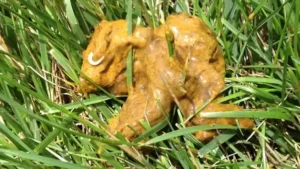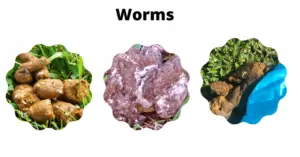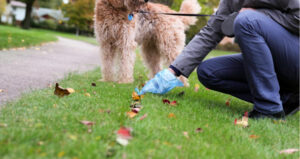Why is there rice in my dog’s poop? You may have noticed that your dog’s poop has a grainy look. This is common and can be caused by several different things. It can also be a sign of health problems, so it’s important to note if the rice appears in your dog’s poop.
Rice in dog poop is a sign of tapeworm infection in your dog. Tapeworms are parasites that live in the intestines of dogs. Typically, they do not cause any health problems for your dog, but there are some cases where they can cause severe damage to your dog’s health and even be fatal.
Tapeworms are also called Dipylidium caninum or Toxocara canis. They are found in the small intestine and large intestines of dogs and cats. While they may pass them through feces, they don’t always appear in them.
Dogs with tapeworms tend to have diarrhea, constipation, and weight loss because their bodies get rid of the parasite by producing less digestive fluids than usual.
Why is there rice in my dog’s poop?
The most likely cause of rice-like poop is tapeworm infection. The parasites that cause this problem are called “flatworms,” and they can be found in dogs’ digestive tracts.
As part of their reproductive cycle, the flatworms shed body segments as part of their process of finding a new host. These segments are called “cysts,” and they look like small grains of rice.
Dogs that eat contaminated food will often get tapeworms because the eggs of these parasites can survive for long periods in soil or on plants where dogs’ feces deposit them before being eaten by other animals (including humans).
If you want to be sure that your dog doesn’t have tapeworms, you should always ensure that he never eats any foods that could contain these parasites – especially raw meat or fish from ponds or swamps where other animals might have been exposed to them too.
Why are tapeworms in dog poop?

Tapeworms in dog poop can be an indicator of poor nutrition and sanitation, which affects the health of your dog’s intestinal tract. They attach themselves to the lining of your dog’s gut (specifically, their small intestine).
However, tapeworms use this attachment to feed off nutrients from your dog’s intestines, like food waste and digested nutrients such as protein and carbohydrates.
They are between 1 and 20 meters long and have many segments, each with a mouth on one end and a scolex at its other end.
The scolex is made up of hooks that allow it to attach to intestinal walls where it will grow and produce eggs which then hatch into larvae after passing through an intermediate host such as a snail or another type of worm (e.g., roundworm).
When tapeworm eggs hatch inside their intermediate host, they release thousands of new tapeworm larvae. They will grow up inside this animal until reaching maturity, when they leave its body and penetrate another animal’s intestine, where they will infect it with another generation of larvae. Once mature larvae leave this second animal’s body for another, the cycle continues.
How do I get rid of my dog’s tapeworms?
If you have a dog with tapeworms, you can get rid of them with a prescription drug called praziquantel. This drug can be administered orally or with injection. It would help if you also tried pumpkin, a good home remedy for treating tapeworms in dogs.
Praziquantel is an antibiotic that kills off the parasites in your dog’s digestive tract. It’s an effective treatment for tapeworms, but it must be administered carefully to avoid side effects.
This is because the drug kills off parasites and bacteria, and some dogs may experience diarrhea or vomiting after taking it. If this happens to your pet, speak with your veterinarian about alternatives to praziquantel.
If you use pumpkin as a remedy for your dog’s tapeworms, give him one tablespoon each day until his symptoms resolve (about two weeks). Be sure not to mix any other foods into this mixture, only pumpkin.
How serious is tapeworms in dogs?

Tapeworms in dogs can be severe and even contagious, but they’re also very treatable. They are parasites in your dog’s gut and attach to your dog’s intestines. When released, eggs travel out of the body via feces or vomit.
You should get a tapeworm diagnosis from your veterinarian if you notice any symptoms of tapeworm infection in your dog, such as:
Constipation (significantly fewer bowel movements than usual)
Loss of appetite (your dog may not want to eat)
Diarrhea (watery stool)
Vomiting (usually with blood mixed with it)
Your vet will perform a fecal exam and look for eggs in your dog’s stool. If there are eggs, they’ll be removed with medication for about three weeks before returning for a follow-up exam to ensure that the tapeworms have been eradicated from your dog’s system.
What does tapeworm look like in dog poop?
Tapeworms are common parasites that can infect your dog. They look like rice, a long, thin, snake-like thread with suckers attached to the end. They can be seen in your pet’s feces and have a flat head that looks like a doughnut or a circle.
Tapeworms live in the intestines and feed on the host animal’s blood. The tapeworm grows until it reaches about 20 feet (6 meters). The tapeworm then produces eggs, passes through the feces, and is deposited in other areas where they can hatch, such as lakes or rivers.
The eggs hatch into tiny larvae, which then develop into tapeworms. It’s essential to watch this parasite because it can cause serious health problems for dogs and humans who come into contact with their waste.
Because it’s so large and dogs eat so much food, a single tapeworm can be dangerous if left untreated (though it may take years).
Can tapeworms be passed from dog to human?

Tapeworms can be passed from a dog to a human. They are intestinal parasites that can be passed from dog to human. They are often found in dogs and cats, but they have been found in other mammals as well.
The tapeworm is a kind of flatworm that grows in the intestines. The tapeworm is made up of a head, which contains about 50 segments; these segments are called proglottids. Each proglottid contains one egg.
The eggs hatch into larvae, then travel through your dog’s intestines. The larvae will mature into adult tapeworms if they reach your dog’s anus (the opening where feces comes out).
Once this happens, they will mate and lay eggs on their bodies, eventually, hatch into parasitic larvae that will take over your pet’s intestines and grow into full-grown adult tapeworms.
Can rice come out in dog poop?
Rice can come out in dog poop. Rice is a grain, like wheat or barley. It’s a whole grain, which means it contains all the nutrients necessary for human health. It’s also high in fiber, which helps to keep your digestive system healthy and can help to prevent colon cancer by preventing constipation (which can lead to colon cancer).
Rice has been used as a food source since the time of ancient Egypt. It was first domesticated in India around 5,000 years ago and has been cultivated ever since. It is still considered one of the most important crops in India today because it accounts for more than half of all food consumed by people there each year.
Does rice fully digest in dogs?

Rice is a grain that’s often used as filler in dog food. It’s also one of the few grains that dogs can digest, but they should eat it only sometimes. The main issue with rice is that it contains gluten, a protein in grains.
Dogs with celiac disease, a condition where their immune system attacks the gluten protein in wheat and other grains, may be able to tolerate rice. Still, it’s best to read labels carefully and avoid feeding them to your dog if you know he has this condition.
Some dogs can also have issues with other proteins in rice, including amylase and trypsin inhibitors. These enzymes are found in most grain products, but these problems are more likely to occur when the grain product is not fully cooked or if other ingredients are present, such as corn or soybeans.
If you’re concerned about your dog having digestion issues due to his diet, talk to your vet about switching him to another type of food.
Why is white stringy stuff in dog poop?
There are a few reasons why you might see white stringy stuff in your dog’s poop. The most apparent reason is tapeworms. Tapeworms are flat, ribbon-like creatures in the intestines of dogs and cats.
They attach themselves to the walls of your pet’s digestive tract and feed off your pet’s blood. The eggs can lay dormant for up to a year before they hatch so that you won’t notice them immediately.
Your dog may not have any symptoms of tapeworm infection, though he may experience diarrhea and vomiting. If you suspect your dog has tapeworms, immediately take him to the vet.
How do I clean my house after tapeworms?

If you’ve got tapeworms, it’s time to get cleaning. The first step is to eliminate any food sources that the worms could have contaminated. This includes any fruits or vegetables that might be infested with worms, even if they seem clean and well-picked or have been washed or peeled.
The worm’s eggs can be left behind on those foods in your fridge or pantry for months, so don’t think twice about throwing them out.
Next, remove any objects that the worms may have contaminated. For example, if you find a sock that has worms living in it, throw it away immediately. If there are toys or other objects in your home where you suspect worms may be living under the fabric’s surface, toss them out.
Finally, clean all areas where you’ve found evidence of worms with soap and warm water. Use an antibacterial spray on surfaces needing extra cleanings, like bed sheets and mattresses. Then dry everything thoroughly before letting it air-dry overnight.
Are tapeworms in dogs an emergency?
Tapeworms in dogs are not an emergency, but they can be severe. While tapeworms in dogs can be very common and mild, the disease is still present, and the dog will need to be treated for it. This can be done through medication and surgery.
Tapeworms in dogs are not a life-threatening problem. However, if you or your dog have been diagnosed with tapeworms, you should contact a vet immediately so that they can start treating your pet as soon as possible.
Can humans catch tapeworms from dogs?
Humans can catch tapeworms from dogs by eating raw or undercooked meat or drinking water contaminated with the feces of infected dogs. Tapeworms are usually transmitted from dogs to humans through contact with their saliva and feces.
Dogs suffering from tapeworms may exhibit diarrhea, weight loss, vomiting, and abdominal pain. Tapeworms can be spread through the feces of infected animals after they defecate on hard surfaces such as sidewalks, patios, and driveways.
When people walk on those surfaces after being exposed to tapeworm eggs in the soil (which is most common), they can come into contact with these eggs by stepping through cracks in the ground or walking over areas where grass has been recently mowed.
Once humans ingest these eggs, they can hatch inside their gut to produce larvae that migrate through the body at different stages of development until they reach maturity inside their intestine walls. These worms can then grow long enough to penetrate
What home remedy kills tapeworms in dogs?

There are lots of home remedies that you can try to kill tapeworms in dogs. Some of the best are pumpkin seeds, apple cider vinegar, and Epsom salt baths.
Pumpkin seeds are high in nitrates which is what kills tapeworms in dogs. You can buy these seeds at any grocery store or online. Just ensure you get organic ones, so they don’t have pesticides on them.
Apple cider vinegar is high in acetic acid, also known as vinegar, and will kill tapeworms in dogs. You can buy this at any grocery store or online as well.
Epsom salt baths are another way to kill tapeworms in dogs because they are very alkaline, which means it has a pH level of around 10-11, which is very high for parasites like tapeworms. These baths also help cleanse the dog’s skin by removing dead cells on the surface so it can heal faster when it gets infected with a parasite like tapeworms again later down the line.
How do you prevent tapeworms in dogs?
Tapeworms are parasitic worms that live inside your dog’s body. They’re often found in flea eggs or feces and can cause serious health problems for your dog (such as anemia and weight loss).
Fortunately, there are ways to prevent these infections, and part of those ways is by using rapid, effective flea treatment on your dog every month or two.
If you don’t have access to a good vet who can treat your dog for this problem on an ongoing basis, get a topical flea product every time you go camping or bring your dog somewhere new (like a neighbor’s house).
Another way to prevent tapeworms in dogs is by ensuring they aren’t eating raw offal (e.g., meat) or scavenging on carcasses where they may pick up fleas infected with the tapeworm eggs. It’s also important not to let dogs lick their paws after cleaning up.
How long does it take for a dog to get rid of tapeworms?
Tapeworms are a common issue for dogs. They can cause many problems for your dog, including weight loss and diarrhea.
The average time it takes for your dog to get rid of tapeworms is two weeks. This is based on the most common type of tapeworm infection in dogs: Echinococcus multilocularis.
This tapeworm infection is spread by fleas and ticks and can be passed from dogs to humans. It’s not always easy to identify this type of tapeworm infection in dogs because it only sometimes appears in blood tests.
That’s why taking your dog to the vet is essential if you notice symptoms like diarrhea or weight loss that aren’t normal for them.
How do you know if tapeworms are gone in dogs?

If your dog has tapeworms, you’ll want to know if they are gone. The easiest way to do this is to take a fecal sample. You can do this by taking a few drops of blood from your dog’s mouth and putting it into a clean, empty test tube. Then, you’ll need to mix the blood with salt water (about 1/4 teaspoon per cup), and then put that solution into an incubator for about 24 hours.
When you take the sample out of the incubator, you’ll be able to see if there are any parasites in it by looking at what color it is under a microscope or even just with your eyes. If no parasite is present, you know the treatment was successful.
Can I get worms from my dog sleeping in my bed?
Tapeworms are parasites that affect many animals, including dogs. They live in the intestines and cause discomfort and loss of appetite. If left untreated, tapeworms can lead to life-threatening anemia and death.
If your dog has tapeworms, you should watch his behavior closely. He may have trouble eating or drinking or drinking excessive water or vomit. You may also see patches of pale skin around your dog’s mouth or anus that look like scabs.
Tapeworms can also be transmitted to humans through contaminated food or water. It would help if you always wash your hands after handling raw meat, eggs, or fish; avoid touching your face with unwashed hands; and thoroughly clean any items that have come into contact with raw meat (such as cutting boards).
Can I deworm my dog myself?
You can deworm your dog yourself. Pumpkin seeds are a very effective deworming agent. If you have a dog that is not eating well or has a history of digestive issues, pumpkin seeds are a great supplement to your dog’s diet.
They contain vitamins A and C, which help absorb other nutrients in the food they eat and provide them with antioxidants. Pumpkin seeds are also high in fiber and protein and can be fed to your dog as a treat or added to their regular meal as part of their daily routine.
What is the best dewormer for dogs?

Pet parents are always looking for the best dewormer for their dogs. There are many different types of dewormers on the market, so it can be unclear what will be best for your pet.
Here is a list of the three best canine dewormers currently available:
1) Safeguard 4 Canine Dewormer: This product is designed for dogs with an active lifestyle and may need a more potent treatment than others. The active ingredient in this product is piperazine citrate, which kills off worms in your dog’s system. It is also a safe product as it contains no parabens or phenoxyethanol.
2) Durvet Triple Dog Wormer: This product contains Droncit, which eliminates roundworms and hookworms from your dog’s body within 24 hours of ingestion. It comes in liquid form, which makes it easy to administer and gives you control over how much medication your pet receives per dose.
3) Sentry HC WormX Plus Dog Dewormer: This product contains Pyrantel Pamoate, which kills adult roundworms and hookworms within 24 hours of ingestion. It also contains Ibuprofen.
Conclusion
Why is there rice in my dog’s poop? You may see rice in your dog’s poop for several reasons. Identifying the cause is essential so you can treat it accordingly.
The most common culprit is a worm. If you have a dog diagnosed with worms, there will likely be rice in their poop. The worms that cause this condition can also cause other issues, such as diarrhea and vomiting.
The best way to treat this problem is to use a medication that kills worms. It would help if you also did regular worm checks on your dog to ensure they are not getting sick again.


